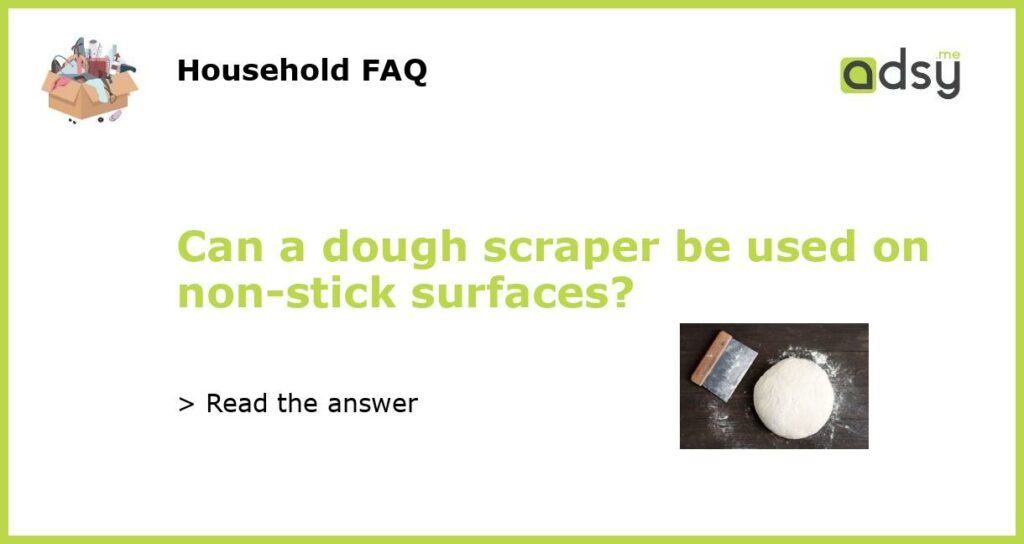Yes, a dough scraper can be used on non-stick surfaces
A dough scraper is a versatile kitchen tool that is commonly used in baking and pastry making. It is an essential tool for working with dough, as it helps to gather, cut, and scrape dough from surfaces. While traditionally made of metal or plastic, there are also dough scrapers specifically designed for non-stick surfaces.
What is a dough scraper?
A dough scraper, also known as a bench scraper, is a flat, rectangular tool with a handle that is used to manipulate dough. It is typically made of metal or plastic and has a sharp edge that can be used to cut dough into portions. The straight edge of the scraper is great for cutting and lifting dough, while the curved edge is ideal for scraping along the sides of bowls or containers to ensure no dough is wasted.
Dough scrapers for non-stick surfaces
If you have a non-stick baking surface or prefer to use a non-stick silicone mat or parchment paper for rolling out dough, there are dough scrapers specifically designed for these surfaces. These non-stick dough scrapers are made of food-grade silicone or plastic that is safe to use on non-stick surfaces without causing damage. The non-stick surface of these scrapers prevents the dough from sticking to the scraper, making it easier to manipulate and clean up.
Benefits of using a dough scraper on non-stick surfaces
Using a dough scraper on non-stick surfaces offers several benefits:
- Efficient dough handling: The sharp edge of a dough scraper allows for precise cutting and division of dough portions. It helps to gather loose pieces of dough, making the process more efficient and preventing any waste.
- Easy cleanup: Non-stick dough scrapers are easy to clean. The dough does not stick to the scraper, minimizing the effort required to remove any residue. Simply rinse or wipe the scraper off, and it will be ready for the next use.
- No damage to non-stick surfaces: Using a non-stick dough scraper ensures that you do not scratch or damage your non-stick baking surfaces, silicone mats, or parchment paper. This helps to prolong the lifespan of these tools and keep them in good condition.
- Versatility: While non-stick dough scrapers are designed for use on non-stick surfaces, they can still be used on other surfaces like wooden cutting boards or stainless steel countertops. This makes them a versatile tool in the kitchen.
- Comfortable grip: Many non-stick dough scrapers feature ergonomic designs with comfortable handles, making them easy to hold and maneuver while working with dough.
Tips for using a dough scraper on non-stick surfaces
Here are some tips to keep in mind when using a dough scraper on non-stick surfaces:
- Choose the right scraper: Look for a dough scraper specifically designed for non-stick surfaces. These scrapers are made of materials that are safe to use on non-stick coatings without causing damage.
- Use a light touch: When using a dough scraper on non-stick surfaces, apply gentle pressure to avoid scratching or damaging the surface.
- Follow the manufacturer’s instructions: Each dough scraper may have specific guidelines and recommendations for use. It is important to follow these instructions to ensure optimal performance and longevity.
- Clean the scraper after each use: Rinse or wipe off the dough scraper after each use to remove any residue. This will help to keep the scraper clean and ready for the next use.
- Store properly: Store your dough scraper in a clean and dry area to prevent any contamination or damage.
In conclusion, a dough scraper can be used on non-stick surfaces. There are dough scrapers specifically designed for non-stick surfaces, made of food-grade silicone or plastic. Using a non-stick dough scraper offers benefits such as efficient dough handling, easy cleanup, no damage to non-stick surfaces, versatility, and comfortable grip. When using a dough scraper on non-stick surfaces, it is important to choose the right scraper, use a light touch, follow the manufacturer’s instructions, clean the scraper after each use, and store it properly.






